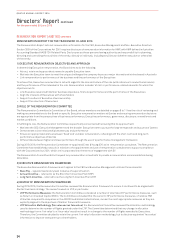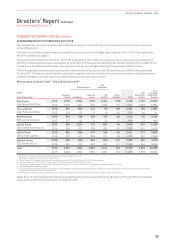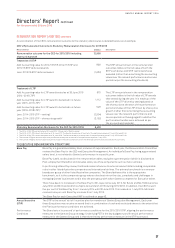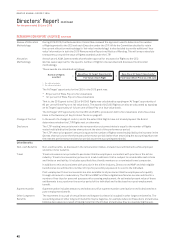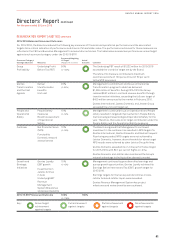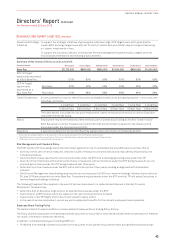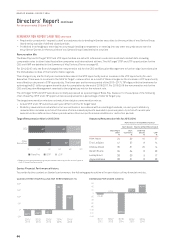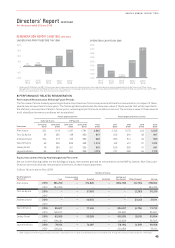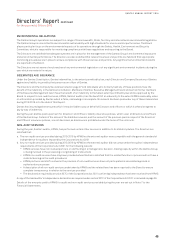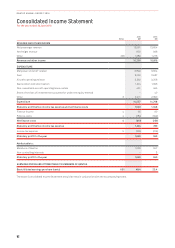Qantas 2016 Annual Report Download - page 44
Download and view the complete annual report
Please find page 44 of the 2016 Qantas annual report below. You can navigate through the pages in the report by either clicking on the pages listed below, or by using the keyword search tool below to find specific information within the annual report.
Directors’ Report continued
For the year ended 30 June 2016
Additional Descriptions of STIP Scorecard Measures
Group Profitability Underlying PBT is the primary financial performance measure for the Qantas Group and therefore, is selected
as the primary performance measure under the STIP. The objective of measuring and reporting Underlying
PBT is to provide a meaningful and consistent representation of the underlying performance of the Group.
The Underlying PBT target is based on the annual financial budget. For reasons of commercial sensitivity, the
annual Underlying PBT target is not disclosed.
Underlying PBT is derived by adjusting Statutory PBT for the impacts of AASB 9 Financial Instruments
which relate to other reporting periods and items which are identified by Management and reported to the
chief operating decision-making bodies, as not representing the underlying performance of the business.
The determination of these items is made after consideration of their nature and materiality and is applied
consistently from period to period.
Items not included in Underlying PBT primarily result from major transformational/restructuring initiatives,
transactions involving investments and impairment of assets outside the ordinary course of business.
Qantas
Transformation and
the Cost Agenda
The Qantas Transformation program is now targeting $2.1 billion of benefits by 2016/2017. Realisation of
benefits under the Qantas Transformation program has been selected as a performance measure under
the STIP as the transformation initiatives are driving sustainable change in the business and have been
fundamental in returning the Qantas Group to profitability and the delivery of a record profit in 2015/2016.
Cost control remains an area of focus across the business and, as a result, the STIP scorecard includes unit
cost targets for Qantas International and Qantas Domestic combined and the Jetstar Group.
For Qantas International and Qantas Domestic, unit cost performance is calculated as net underlying expenditure
(excluding fuel) divided by each business’ Available Seat Kilometres (ASK). Net underlying expenditure is derived
from passenger revenue less Underlying EBIT.
For Jetstar Group, unit cost performance is measured as controllable unit cost, which is calculated as total
expenses (excluding fuel and costs associated with minority investments in Jetstar Airlines in Asia) per ASK
adjusted for sector length and foreign exchange.
To ensure that these measures focus on the underlying operating activities and efficiencies, they exclude the
impact of fuel price changes and foreign exchange movements, as well as items not included in Underlying
PBT as described above.
People and
Operational Safety
As safety is always our first priority, the STIP scorecard includes an assessment of both operational and
people safety. In addition, the Board retains an overriding discretion to scale down the STIP (or reduce it to
zero) in the event of a material aviation safety incident. This is in addition to the Board’s overall discretion
over STIP awards. Any such decision would be made in light of the specific circumstances and following the
recommendation of the Safety, Health, Environment and Security Committee.
The Safety, Health, Environment and Security Committee performs a combined assessment of people safety
performance and operational safety performance.
The objective of the people safety targets is to reduce employee injuries and therefore, targets were set across:
− Total Recordable Injury Frequency Rate
− Lost Work Case Frequency Rate
− Duration Rate
Operational safety performance is assessed against outcome-based measures (including operational
occurrences that pose a significant threat to the safety of employees and customers) and risk-based lead
indicators commonly associated with aviation industry accidents.
Customer Customer service is measured against NPS targets.
This is a survey-based measure of how strongly our customers promote the services of our businesses
in preference to our direct competitors. Individual NPS targets are set for Qantas Domestic, Qantas
International, Qantas Frequent Flyer, Jetstar Australia Domestic, Jetstar Australia Long Haul, Jetstar Asia,
Jetstar Japan and Jetstar Pacific.
On-time departures for Qantas Domestic continues to be a particular area of focus. Therefore, a target
measuring Qantas Domestic on-time departures is included as a STIP measure. As agreed with and reported
to the Bureau of Infrastructure, Transport and Regional Economics (BITRE), punctuality is measured as the
number of flights operating on-time (on an on-time departure basis) as a percentage of the total number of
flights operated.
REMUNERATION REPORT (AUDITED) CONTINUED
42
QANTAS ANNUAL REPORT 2016




